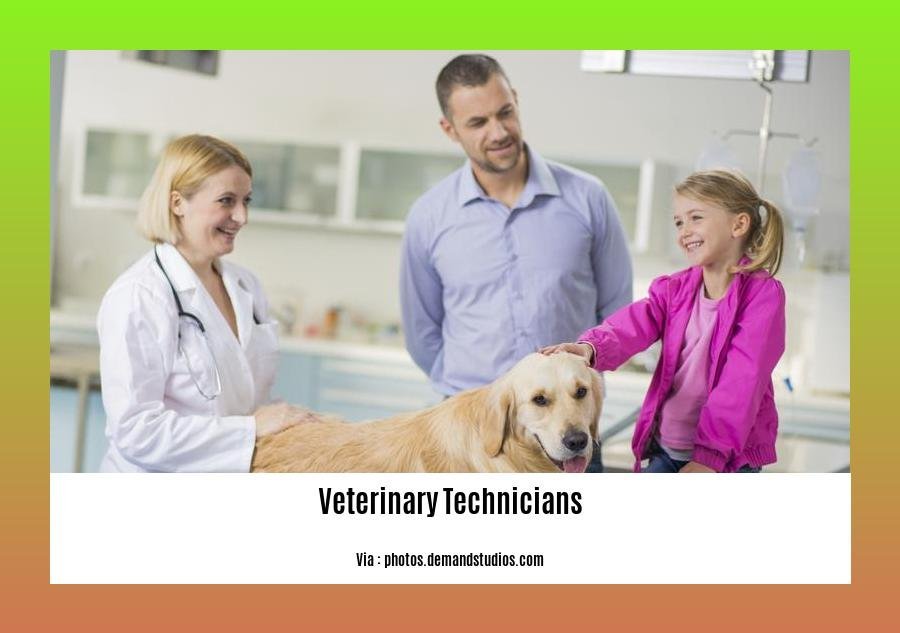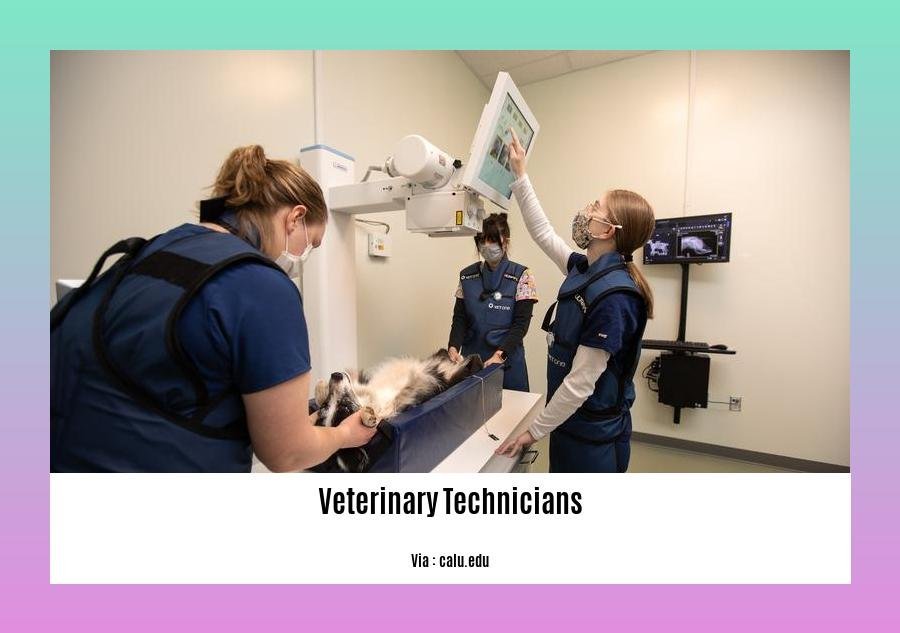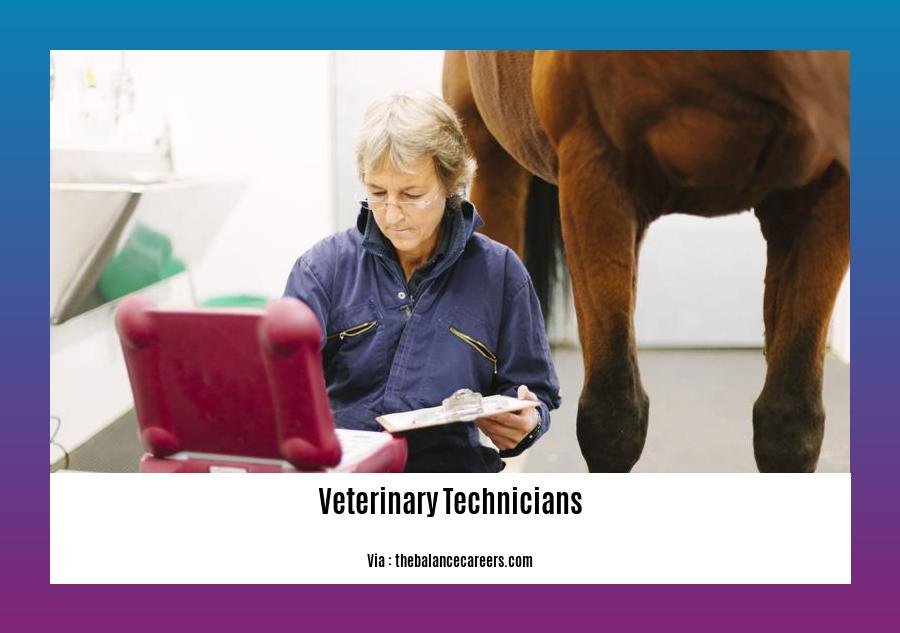If you’ve ever wondered about the crucial role veterinary technicians play in animal healthcare, look no further. In this article, we’ll explore 10 important facts about veterinary technicians. With their extensive knowledge and skill set, these highly experienced professionals are essential members of the veterinary team, ensuring the well-being and care of our beloved animals. So, let’s dive in and discover the fascinating world of veterinary technicians and the valuable contributions they make to the field of animal medicine.
Key Takeaways:
- Veterinary technicians perform medical tests to diagnose animals’ injuries and illnesses in various settings such as clinics, laboratories, and animal hospitals.
- The job of a veterinary technician can be physically and emotionally demanding.
- The majority of veterinary technicians, around 82.2%, are women, while around 17.8% are men.
- The average age of employed veterinary technicians is 32 years old.
- Veterinary technicians have a wide range of responsibilities, including serving as patient advocates, phlebotomists, radiology technicians, laboratory technicians, anesthesia technicians, and surgery technicians.
- Veterinary technicians provide both emergency and routine medical care for animals, utilizing their clinical skills and knowledge.
- These key facts are based on data from the Bureau of Labor Statistics and Zippia.
Facts About Veterinary Technicians

As an integral part of the veterinary healthcare team, veterinary technicians play a crucial role in providing quality care to animals. Here are some important and interesting facts about veterinary technicians:
1. Medical Diagnostics and Care
Veterinary technologists and technicians perform a wide range of medical tests to diagnose and treat animals’ injuries and illnesses. They work closely with veterinarians to collect samples, conduct laboratory tests, and provide critical support in determining appropriate treatment.
2. Diverse Work Environments
Veterinary technicians can be found working in various settings, including private clinics, laboratories, and animal hospitals. Their expertise allows them to contribute to the well-being of animals across different healthcare facilities, ensuring that pets and wildlife receive the necessary care.
3. Demographic Insights
Did you know that approximately 82.2% of veterinary technicians are women, while 17.8% are men? This profession offers opportunities for individuals from diverse backgrounds. The average age of an employed veterinary technician is 32 years old, reflecting a dynamic and evolving field.
4. Multifaceted Roles
Veterinary technicians serve as patient advocates, phlebotomists, radiology technicians, laboratory technicians, anesthesia technicians, and surgery technicians. They wear many hats, utilizing their extensive clinical skills and knowledge to provide well-rounded care to animals.
5. Emergency and Routine Care
Veterinary technicians are involved in both emergency and routine medical care for animals. They are trained to handle critical situations, administer treatments, monitor anesthesia, and provide essential support during surgeries. Whether it’s a life-saving intervention or routine health maintenance, veterinary technicians are instrumental in improving animal welfare.
6. Commitment to Animal Well-being
Veterinary technicians are passionate advocates for animal health and well-being. They work closely with pet owners, educating them about preventive care, nutrition, and medication administration. Their compassion and empathy ensure that animals receive the attention and care they deserve.
7. An Essential Support System
Just like the backbone of any healthcare team, veterinary technicians provide vital assistance to veterinarians. They help with patient assessments, take radiographs, collect and analyze lab samples, administer medications, and carry out numerous other tasks. Veterinary technicians are indispensable in providing high-quality and efficient care for animals.
8. Continuous Learning and Professional Growth
In order to stay current with the latest advancements in veterinary medicine, veterinary technicians engage in continuing education. They attend workshops, conferences, and online courses to enhance their skills and knowledge. This dedication to professional growth ensures that they provide the best care possible to their animal patients.
9. Physical and Emotional Demands
The job of a veterinary technician can be physically and emotionally demanding. Handling animals of various sizes and temperaments requires physical strength and agility. Additionally, veterinary technicians often work with distressed or injured animals, requiring emotional resilience and the ability to provide compassionate care.
10. Contributing to Research and Wildlife Conservation
Veterinary technicians also play a crucial role in research and wildlife conservation. They assist in conducting research trials, monitoring animals in rehabilitation facilities, and providing specialized care for wildlife. Their expertise contributes to the understanding and preservation of animal species.
Overall, veterinary technicians are highly skilled professionals who work tirelessly to ensure the health and well-being of animals. Their diverse roles, commitment to continuous learning, and dedication to providing exceptional care make them an essential part of the veterinary healthcare team.
Table: Demographics of Veterinary Technicians
| Gender | Percentage |
|---|---|
| Women | 82.2% |
| Men | 17.8% |
Sources:
1. Bureau of Labor Statistics – Veterinary Technologists and Technicians
2. Zippia – Veterinary Technician demographics and statistics
Check out these fascinating facts about therapy dogs! (Link: facts about therapy dogs)
Discover the amazing world of water animals and learn interesting facts about them. (Link: facts about water animals)
Learn about the hard-working dogs and the incredible tasks they perform. (Link: facts about working dogs)
The wide range of duties and responsibilities veterinary technicians have

As a veterinary technician, you might be surprised to discover the wide range of duties and responsibilities that come with the job. From providing medical care to animals, assisting in surgeries, conducting laboratory tests, and even educating pet owners, veterinary technicians play an essential role in the healthcare team.
Here are 10 important facts about the duties and responsibilities of veterinary technicians:
1. Nursing Duties and Patient Advocacy
Veterinary technicians are responsible for providing nursing care to animals, including monitoring vital signs, administering medications, and assisting with medical procedures. They also act as patient advocates, ensuring the well-being and comfort of the animals under their care.
2. Phlebotomy and Laboratory Work
Drawing blood samples and conducting laboratory tests are crucial tasks performed by veterinary technicians. They collect samples, analyze them, and assist in determining appropriate treatments for animals’ injuries and illnesses.
3. Radiology and Diagnostic Imaging
Veterinary technicians are skilled in radiography and diagnostic imaging. They capture X-rays and images, aiding in the diagnosis of various conditions and assisting veterinarians in developing treatment plans.
4. Anesthesia and Surgery Assistance
During surgical procedures, veterinary technicians play a crucial role. They prepare the operating room, handle surgical instruments, monitor anesthesia, and provide support to veterinarians throughout the surgery.
5. Strong Interpersonal Skills
Successful veterinary technicians possess strong interpersonal skills. They interact with pet owners and collaborate with the veterinary team, ensuring effective communication and understanding of the animals’ needs.
6. Technical Skills and Specialized Equipment
Veterinary technicians require good technical skills to perform various procedures. They are trained to use specialized equipment such as ultrasound machines, dental tools, and laboratory instruments to provide comprehensive care to animals.
7. Emotional Resilience
The job of a veterinary technician can be emotionally demanding. These professionals often deal with seriously ill animals and assist with euthanasia. They also encounter clients who may have unrealistic expectations, such as believing that pet care should be free. Emotional resilience is crucial in providing compassionate care.
8. Continuous Education and Advancements
To stay updated on advancements in veterinary medicine, veterinary technicians engage in ongoing education. They attend conferences, workshops, and seminars to expand their knowledge and improve their skills, ensuring they can provide the best care possible.
9. Surgical and Diagnostic Assisting
Apart from routine care, veterinary technicians contribute to research and wildlife conservation. They assist in research trials, monitor animals in rehabilitation facilities, and provide specialized care for wildlife, playing a vital role in saving and protecting animal lives.
10. Salary and Career Opportunities
The salary of veterinary technicians can vary depending on factors such as experience, location, and the type of practice they work in. With their diverse skill set and expertise, veterinary technicians have excellent career opportunities in private clinics, laboratories, and animal hospitals.
Key Takeaways:
- Veterinary technicians have diverse roles and responsibilities in animal care, including nursing duties, patient advocacy, phlebotomy, radiology, laboratory work, anesthesia, and surgery assistance.
- They possess the technical skills required to perform various procedures and use specialized equipment.
- Veterinary technicians play a crucial role in surgical procedures, preparing operating rooms, handling instruments, and supporting veterinarians during surgery.
- They interact with pet owners and collaborate with the veterinary team, utilizing strong interpersonal skills.
- Emotional resilience is essential for veterinary technicians when dealing with seriously ill animals and challenging situations.
- Continuous education is crucial for veterinary technicians to stay updated on advancements in the field of veterinary medicine.
- In addition to routine care, veterinary technicians also contribute to research and wildlife conservation.
- Salary in the veterinary technician field can vary based on experience, location, and practice type.
Citation:
– AAHA: What Is a Veterinary Technician
– The Academy of Pet Careers: Vet Tech Job Description
The Importance of Veterinary Technicians in Surgical Procedures
Veterinary technicians play a pivotal and multi-faceted role in the field of animal care and medicine. Their expertise and involvement in surgical procedures are invaluable for the overall well-being of animals. In this article, we will explore the significance of veterinary technicians in surgical procedures and the crucial support they provide to veterinarians.
The Role of Veterinary Technicians in Surgical Procedures
Veterinary technicians are essential members of the surgical team, serving as surgical assistants and circulating nurses. They provide vital support to veterinarians before, during, and after surgeries. From preparing the operating room to handling surgical instruments, veterinary technicians ensure a smooth and efficient surgical procedure. Their involvement encompasses various surgical procedures, including both common and advanced ones depending on the anatomical location.
The Expertise and Skills of Veterinary Technicians
Well-trained veterinary technicians possess a diverse range of skills that qualify them to perform a wide array of clinical tasks. In addition to taking patient histories and collecting specimens, they are trained to perform advanced medical procedures and assist in surgeries. With a higher level of education and skills compared to veterinary assistants, veterinary technicians play a pivotal role in ensuring the success of surgical procedures.
Key Responsibilities of Veterinary Technicians in Surgical Procedures
During surgical procedures, veterinary technicians shoulder essential responsibilities that contribute to the well-being of animals. These include:
Preparing the Operating Room: Veterinary technicians ensure that the surgical suite is properly set up and fully equipped with the necessary instruments and supplies.
Assisting the Veterinarian: They provide direct assistance to veterinarians during surgeries, handing them instruments, monitoring vital signs, and providing necessary support.
Monitoring Anesthesia: Veterinary technicians closely monitor anesthesia administration, ensuring the animal’s well-being and adjusting anesthesia levels as needed.
Sterilization and Maintenance of Instruments: They are responsible for cleaning, sterilizing, and organizing surgical instruments, ensuring their readiness for each procedure.
Post-Operative Care: After surgery, veterinary technicians monitor the recovery process, administer medications, change dressings, and provide the necessary post-operative care to promote healing.
The Contributions of Veterinary Technicians in Surgical Procedures
The important contributions and support provided by veterinary technicians in surgical procedures are essential for the successful outcome of surgeries and the overall well-being of animals. By collaborating closely with veterinarians, they ensure that surgeries are conducted efficiently, safely, and with the utmost care.
Key Takeaways:
- Veterinary technicians are crucial members of the surgical team, serving as surgical assistants and circulating nurses.
- They play a vital role in preparing the operating room, handling surgical instruments, and providing support to veterinarians during surgeries.
- Veterinary technicians possess a diverse range of skills and expertise, allowing them to perform advanced medical procedures and assist in surgeries.
- Their responsibilities include preparing the operating room, assisting the veterinarian, monitoring anesthesia, and providing post-operative care.
- The contributions of veterinary technicians in surgical procedures are essential for the successful outcome of surgeries and the overall well-being of animals.
Sources:
– Wiley Online Library
– American Veterinary Medical Association
The Ongoing Advancements in Veterinary Technology and Its Impact on Veterinary Technicians
The field of veterinary medicine has been transformed by ongoing advancements in technology. These innovations have had a profound impact on the work of veterinary technicians, enhancing their ability to provide high-quality care to animals. Let’s explore some key facts about the ongoing advancements in veterinary technology and how they are affecting veterinary technicians.
Precision Imaging and Molecular Diagnostics
- Precision imaging and molecular diagnostics are cutting-edge technologies that allow veterinarians to gain detailed insights into an animal’s health. With precision imaging, veterinarians can detect tumors, fractures, and other internal issues with remarkable accuracy. Molecular diagnostics enable veterinarians to identify specific genetic markers and personalize treatment options for animals.
- These advancements empower veterinary technicians to assist in the accurate diagnosis of diseases and the development of personalized treatment plans.
Telemedicine in Veterinary Care
- The rise of telemedicine has revolutionized the way veterinary care is delivered. This technology allows pet owners to remotely consult with veterinarians, reducing the need for physical visits. For individuals living in rural areas or facing transportation challenges, telemedicine provides easier access to veterinary care.
- Veterinary technicians play a crucial role in telemedicine by facilitating remote consultations and helping pet owners navigate virtual healthcare options.
Robotics and Automation
- Robotics and automation are transforming various aspects of veterinary practice, particularly in surgical procedures. Robotic systems have enhanced precision, reducing the risks associated with human error during surgeries. Additionally, robotics assist in rehabilitation therapy, improving the recovery process for injured animals.
- Veterinary technicians work alongside veterinarians during robotic surgeries, ensuring the seamless operation of these advanced technologies.
3D Printing in Veterinary Medicine
- 3D printing technology has revolutionized personalized care for animals. Veterinarians can create customized implants, prosthetics, and surgical tools through 3D printing. This technology improves the quality of life for animals by providing tailored solutions that perfectly fit their individual needs. Additionally, 3D printing contributes to advancements in regenerative medicine.
- Veterinary technicians actively participate in the process of 3D printing, assisting veterinarians in creating customized solutions and implementing them during procedures.
Wearable Technology
- Wearable technology and Internet of Things (IoT) applications are transforming the field of veterinary science. High-tech wearable devices enable the remote monitoring of animals’ vital signs, behavior patterns, and overall health. Real-time data obtained through wearable technology allows veterinarians to make more accurate diagnoses and provide timely interventions.
- Veterinary technicians incorporate wearable technology into their patient care practices, utilizing the data collected to assess animal health and identify early signs of diseases or abnormalities.
Key Takeaways:
– Precision imaging and molecular diagnostics enable precise diagnosis and personalized treatment options for animals.
– Telemedicine improves access to veterinary care, especially for remote areas, with veterinary technicians assisting in remote consultations.
– Robotics and automation enhance surgical precision and rehabilitation therapy, with veterinary technicians providing support during procedures.
– 3D printing revolutionizes personalized care for animals, allowing veterinarians to create customized solutions.
– Wearable technology provides real-time monitoring of animals’ health, aiding in early detection of health issues, and involving veterinary technicians in the data analysis process.
Sources:
– Vetport: Recent Technological advancements in veterinary medicine
– Vet Times: Technology advances and the impact on veterinary practices
FAQ
Q1: What are the key responsibilities of veterinary technicians?
A1: Veterinary technicians perform a variety of tasks, including taking detailed patient histories, performing physical exams, administering medications, and teaching pet owners how to administer medications at home.
Q2: What roles do veterinary technicians play in surgical procedures?
A2: Veterinary technicians have a major role to play during surgical procedures. They serve as surgical assistants and circulating nurses, providing crucial support to veterinarians. They are involved in various common and advanced surgical procedures based on the anatomical location.
Q3: How do veterinary technicians contribute to the field of veterinary medicine?
A3: Veterinary technicians support veterinarians in providing medical care, assist in surgical procedures, and play a crucial role in driving change in the veterinary profession. Their skills and expertise contribute significantly to the overall well-being of animals.
Q4: What are the challenges faced by veterinary technicians?
A4: Veterinary technicians may face emotional stress due to their close interactions with animals and pet owners, particularly when dealing with serious illnesses or euthanasia. They can also encounter clients who believe pet care should be free.
Q5: How do technological advancements impact veterinary technicians?
A5: Technological advancements in veterinary medicine have significantly improved the level of care and treatment available for animals. Precision imaging, robotics, telemedicine, wearable technology, and 3D printing are examples of technologies that are revolutionizing the field and enhancing the work of veterinary technicians.












